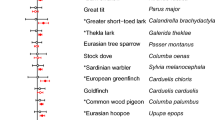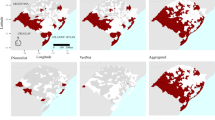Abstract
The effectiveness of surveys of breeding birds varies due to multiple factors, with the primary being imperfect detection, which is particularly severe for elusive species. For example, the territory mapping method requires surveying an area multiple times a season to compensate for missing individuals during single surveys. Novel methods require much less effort in the field and include estimation of both detection probability and abundance corrected for individuals that went undetected. The aim of this study was to check if point counts and model-based results provide estimates similar to the ones from the territory mapping method. We studied the abundance of two forest birds—Goldcrest Regulus regulus and Firecrest R. ignicapilla—on three permanent census plots in the Białowieża Forest (E Poland). We compared abundance estimates resulting from the territory mapping method in its ‘standard’ (~ 10 visits) and intensive (~ 20 visits) approaches. We also performed point counts at the same plots using distance sampling methodology and hierarchical models in an attempt to get unbiased estimates by correcting for imperfect detection. We found that the standard territory mapping method produces much lower abundances than model-based estimates, which was particularly evident for the more numerous Firecrest. At the same time, results from point counts were more consistent with numbers from the intensive territory mapping. Our findings suggest that applying point counts and distance sampling models meet modern standards by considering various effects in abundance, availability and detection processes along with providing uncertainty of their estimates. We assume that our results might be applicable to other elusive species.
Zusammenfassung
Bestandsschätzungen anhand von Punktzählungen und Revierkartierungen: Vergleich verschiedener Ansätze für zwei Regulus-Arten
Die Effektivität von Brutvogelerhebungen variiert aufgrund mehrerer Faktoren, wobei der wichtigste Faktor die unzureichende Erfassung (d. h. die eingeschränkte Wahrnehmung durch den Menschen) ist, die besonders bei der Erfassung schwer erfassbarer Arten eine Rolle spielt. Die Methode der Revierkartierung erfordert beispielsweise, dass ein Gebiet mehrmals pro Saison begangen wird, um dem Problem entgegenzuwirken, dass Individuen bei einzelnen Erhebungen übersehen werden. Neuartige Methoden erfordern einen wesentlich geringeren Aufwand im Feld und umfassen sowohl eine Abschätzung der Entdeckungswahrscheinlichkeit als auch des Bestandes, der um nicht entdeckte Individuen korrigiert wurde. Ziel dieser Studie war es, zu überprüfen, ob Punktzählungen und modellbasierte Ergebnisse ähnliche Schätzungen liefern wie die Methode der Revierkartierung. Dazu untersuchten wir den Bestand von zwei Waldvogelarten – des Wintergoldhähnchens Regulus regulus und des Sommergoldhähnchens R. ignicapilla – auf drei festgelegte Zählflächen im Białowieża-Urwald (Ostpolen). Wir verglichen die Bestandsschätzungen, die auf Revierkartierungen in einer „standardisierter “ (~ 10 Begehungen) und einer intensivierten (~ 20 Begehungen) Form basieren. Außerdem haben wir auf denselben Flächen Punktzählungen durchgeführt, wobei wir die „Distance-Sampling-Methode “ und hierarchische Modelle verwendet haben, um über die Korrektur unzureichender Erfassungen unverfälschte Schätzungen zu erhalten. Wir fanden heraus, dass die standardisierte Revierkartierung zu wesentlich geringeren Bestandszahlen führt als modellbasierte Schätzungen, was besonders beim in größerer Anzahl vorhandenen Sommergoldhähnchen deutlich wurde. Gleichzeitig stimmten die Ergebnisse der Punktzählungen besser mit den Zahlen der intensiven Revierkartierung überein. Unsere Ergebnisse deuten darauf hin, dass die Anwendung von Punktzählungen und hierarchischem „Distance-Sampling “ modernen Standards entspricht, indem sie verschiedene Effekte in Bezug auf Bestand, Verwendbarkeit und Erfassungsprozesse berücksichtigt und zugehörige Schätzungsungenauigkeiten liefert. Wir gehen davon aus, dass unsere Ergebnisse auch auf andere schwer erfassbare Arten übertragbar sind.






Similar content being viewed by others
Data availability
Data are available on request from the corresponding author.
References
Best LB (1975) Interpretational errors in the “mapping method” as a census technique. Auk 92:452–460. https://doi.org/10.2307/4084601
Bibby CJ, Burgess ND, Hill DA (2000) Bird census techniques. Academic Press, London
Borchers DL (2012) A non-technical overview of spatially explicit capture-recapture models. J Ornithol 152:435–444
Bötsch Y, Jenni L, Kéry M (2020) Field evaluation of abundance estimates under binomial and multinomial N-mixture models. Ibis 162:902–910. https://doi.org/10.1111/ibi.12802
Buckland ST, Rexstad EA, Marques TA, Oedekoven CS (2015) Distance sampling: methods and applications. Springer. https://doi.org/10.1007/978-3-319-19219-2
Burnham KP, Anderson DR (2002) Model selection and multimodel inference: a practical information-theoretic approach, 2nd edn. Springer-Verlag, New York
Chandler RB, Royle JA, King DI (2011) Inference about density and temporary emigration in unmarked populations. Ecology 92:1429–1435. https://doi.org/10.1890/10-2433.1
Chodkiewicz T, Chylarecki P, Sikora A, Wardecki Ł, Bobrek R, Neubauer G, Marchowski D, Dmoch A, Kuczyński L (2019) Raport z wdrażania art. 12 Dyrektywy Ptasiej w Polsce w latach 2013–2018: stan, zmiany, zagrożenia. Biuletyn Monitoringu Przyrody 20:1–80
Cramp S (1998) Cramp’s the complete birds of the Western Palearctic. Oxford Univ Press, Oxford
Dyderski MK, Paź S, Frelich LE, Jagodziński AM (2018) How much does climate change threaten European forest tree species distributions? Global Change Biol 24:1150–1163. https://doi.org/10.1111/gcb.13925
Faliński JB (1986) Vegetation dynamics in temperate lowland primeval forests. Springer, Netherlands. https://doi.org/10.1007/978-94-009-4806-8
Fiske I, Chandler R (2011) unmarked: an R package for fitting hierarchical models of wildlife occurrence and abundance. J Stat Soft 43:1-23. https://doi.org/10.18637/jss.v043.i10
Flade M (1994) Die Brutvogelgemeinschaften Mittel- und Norddeutschlands. Grundlagen für den Gebrauch vogelkundlicher Daten in der Landschaftsplanung. IHW-Verlag, Eching.
Gnielka R (1990) Anleitung Zur Brutvogelkartierung. Apus 7:145–239
Gnielka R (1992) Möglichkeiten und Grenzen der Revierkartierungsmethode. Vogelwelt 113:231–240
Gottschalk TK, Huettmann F (2011) Comparison of distance sampling and territory mapping methods for birds in four different habitats. J Ornithol 152:421–429. https://doi.org/10.1007/s10336-010-0601-1
Gregory RD, Gibbsons DW, Donald PF (2004) Bird census and survey techniques. In: Sutherland WJ, Newton I, Green R (eds) Bird ecology and conservation: a handbook of techniques. Oxford Univ. Press, New York, pp 17–54
Haftorn S (1978) Cooperation between the male and female Goldcrest Regulus regulus when rearing overlapping double broods. Ornis Scand 9:124. https://doi.org/10.2307/3675873
Jaroszewicz B, Cholewińska O, Gutowski JM, Samojlik T, Zimny M, Latałowa M (2019) Białowieża Forest—a relic of the high naturalness of european forests. Forests 10:849. https://doi.org/10.3390/f10100849
Joseph LN, Elkin C, Martin TG, Possingham HP (2009) Modeling abundance using N-mixture models: the importance of considering ecological mechanisms. Ecol Appl 19:631–642. https://doi.org/10.1890/07-2107.1
Kellner KF, Smith AD, Royle JA, Kéry M, Belant JL, Chandler RB (2023) The unmarked R package: twelve years of advances in occurrence and abundance modelling in ecology. Methods Ecol Evol. https://doi.org/10.1111/2041-210X.14123
Kéry M, Royle JA (2016) Applied hierarchical modeling in ecology. In: Analysis of distribution, abundance and species richness in R and BUGS. Vol. 1. Prelude and static models. Academic Press, London
Kéry M, Schaub M (2012) Bayesian population analysis using WinBUGS: a hierarchical perspective. Academic Press, London
Link WA, Schofield MR, Barker RJ, Sauer JR (2018) On the robustness of N-mixture models. Ecology 99:1547–1551. https://doi.org/10.1002/ecy.2362
Lõhmus A (2022) Absolute densities of breeding birds in Estonian forests: a synthesis. Acta Ornithol 57:29–47. https://doi.org/10.3161/00016454AO2022.57.1.003
Neubauer G, Sikora A (2020) Abundance estimation from point counts when replication is spatially intensive but temporally limited: comparing binomial N-mixture and hierarchical distance sampling models. Ornis Fenn 97:131–148
Neubauer G, Wolska A, Rowiński P, Wesołowski T (2022) N -mixture models estimate abundance reliably: A field test on Marsh Tit using time-for-space substitution. Ornithol Appl 124:duab054. https://doi.org/10.1093/ornithapp/duab054
Niethammer G, Bauer KM, Glutz von Blotzheim UN, Bezzel E (1991) Handbuch der Vögel Mitteleuropas: Passeriformes. Aula Verlag, Wiesbaden, Sylviidae
Paul JT, Roth RR (1983) Accuracy of a version of the spot-mapping census method. J Field Ornithol 54:42–49
Ralph CJ, Geupel GR, Pyle P, Martin TE, DeSante DF (1993) Handbook of field methods for monitoring landbirds. Gen Tech Re PSW GTR-144. Albany, CA: Pacific Southwest Research Station, Forest Service, US Department of Agriculture. https://doi.org/10.2737/PSW-GTR-144
R Core Team (2022) R: a language and environment for statistical computing. R Foundation for Statistical Computing, Vienna. https://www.R-project.org
Royle JA (2004) N–mixture models for estimating population size from spatially replicated counts. Biometrics 60:108–115. https://doi.org/10.1111/j.0006-341X.2004.00142.x
Samojlik T, Rotherham ID, Jędrzejewska B (2013) The cultural landscape of royal hunting gardens from the fifteenth to the eighteenth century in Białowieża Primeval Forest. In: Roterham ID (ed) Cultural severance and the environment. Springer, pp 191–204
Sillett TS, Chandler RB, Royle JA, Kéry M, Morrison SA (2012) Hierarchical distance-sampling models to estimate population size and habitat-specific abundance of an island endemic. Ecol Appl 22:1997–2006. https://doi.org/10.1890/11-1400.1
Snow DW, Perrins CM (1998) The birds of the Western Palearctic. Oxford University Press
Svensson SE (1979) Census efficiency and number of visits to a study plot when estimating bird densities by the territory mapping method. J Appl Ecol 16:61. https://doi.org/10.2307/2402728
Thompson WL (2004) Sampling rare or elusive species: concepts, designs, and techniques for estimating population parameters. Island Press
Tomiałojć L (1980) The combined version of the mapping method. In: Oelke H (ed) Bird census work and nature conservation. Dachverband Deutscher Avifaunisten, Göttingen, pp 92–106
Tomiałojć L (2004) Accuracy of the mapping technique for a dense breeding population of the Hawfinch Coccothraustes coccothraustes in a deciduous forest. Acta Ornithol 39:67–74
Tomiałojć L, Lontkowski J (1989) A technique for censusing territorial Song Thrushes Turdus philomelos. Ann Zool Fenn 26:235–243
Tomiałojć L, Walankiewicz W, Wesołowski T (1977) Methods and preliminary results of the bird census work in primeval forest of Białowieża National Park. Pol Ecol Stud 3:215–223
Tomiałojć L, Wesołowski T, Walankiewicz W (1984) Breeding bird community of a primaeval temperate forest (Bialowieza National Park, Poland). Acta Ornithol 20:241–310
Treml V, Mašek J, Tumajer J, Rydval M, Čada V, Ledvinka O, Svoboda M (2022) Trends in climatically driven extreme growth reductions of Picea abies and Pinus sylvestris in Central Europe. Global Change Biol 28:557–570. https://doi.org/10.1111/gcb.15922
Walankiewicz W, Czeszczewik D, Mitrus C, Szymura A (1997) How the territory mapping technique reflects yearly fluctuations in the Collared Flycatcher Ficedula albicollis numbers. Acta Ornithol 32:201–207
Wesołowski T, Rowiński P, Mitrus C, Czeszczewik D (2006) Breeding bird community of a primeval temperate forest (Białowieża National Park, Poland) at the beginning of the 21st century. Acta Ornithol 41:55–70
Wesołowski T, Mitrus C, Czeszczewik D, Rowiński P (2010) Breeding bird dynamics in a primeval temperate forest over 35 years: variation and stability in a changing world. Acta Ornithol 45:209–232
Wesołowski T, Czeszczewik D, Hebda G, Maziarz M, Mitrus C, Rowiński P (2015) 40 years of breeding bird community dynamics in a primeval temperate forest (Białowieża National Park, Poland). Acta Ornithol 50:95–120
Wesołowski T, Czeszczewik D, Hebda G, Maziarz M, Mitrus C, Rowiński P, Neubauer G (2022) Long-term changes in breeding bird community of a primeval temperate forest: 45 years of censuses in the Białowieża National Park (Poland). Acta Ornithol 57:71–100. https://doi.org/10.3161/00016454AO2022.57.1.005
Winiarska DM, Szymański P, Osiejuk TS (2023) Detection ranges of forest bird vocalisations: guidelines for passive acoustic monitoring. https://doi.org/10.21203/rs.3.rs-2996497/v1
Acknowledgements
We are very thankful to Tomasz Wesołowski, Cezary Mitrus, Dorota Czeszczewik and Fabian Przepióra who participated in territory mapping surveys. We thank Daniel O’Connell for improving our English. We are grateful to Thomas Gottschalk and two anonymous reviewers for their helpful comments on the earlier version of this paper.
Funding
This study was supported by the University of Wrocław.
Author information
Authors and Affiliations
Contributions
All authors contributed to the study design, data collection in the field and material preparation. Data analysis was performed by Grzegorz Neubauer and Julia Barczyk. Julia Barczyk wrote the first draft of the manuscript and all authors commented on previous versions of the manuscript. All authors read and approved the final manuscript.
Corresponding author
Ethics declarations
Conflict of interest
No conflict of interest.
Ethical approval
The research was conducted in compliance with the permissions from the Białowieża National Park.
Additional information
Communicated by T. Gottschalk.
Publisher's Note
Springer Nature remains neutral with regard to jurisdictional claims in published maps and institutional affiliations.
Supplementary Information
Below is the link to the electronic supplementary material.
Rights and permissions
Springer Nature or its licensor (e.g. a society or other partner) holds exclusive rights to this article under a publishing agreement with the author(s) or other rightsholder(s); author self-archiving of the accepted manuscript version of this article is solely governed by the terms of such publishing agreement and applicable law.
About this article
Cite this article
Barczyk, J., Cholewa, M. & Neubauer, G. Abundance estimation from point counts and territory mapping: comparing different approaches for two Regulus species. J Ornithol (2024). https://doi.org/10.1007/s10336-024-02151-6
Received:
Revised:
Accepted:
Published:
DOI: https://doi.org/10.1007/s10336-024-02151-6




